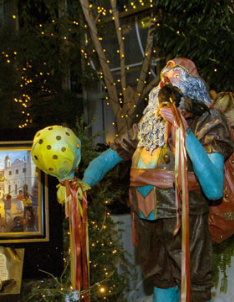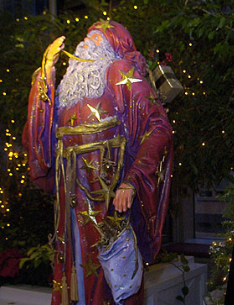Holiday Spirits (of Giving)

photo by Roman Hladio
December 20, 2018
Holiday season is upon us once again. Throughout the course of about a month, many of us will be spending an inordinate amount of time with extended family, and for some, it’s usually enough to reinstate the belief that seeing them once a year is more than enough. It also starts the swarm of holiday content from every form of media, including our beloved Uproar.
Let’s take a step back from all this, though. Many of us have a hard time seeing the world past the boundaries of North Allegheny, much less the U.S. as a whole, but other cultures have differing secular beliefs, no matter how similar they might be, and Pittsburgh is a prime place for discovering this. The PPG Place downtown puts up a “Spirits of Giving from Around the World” exhibit every year, and stepping inside is truly like walking in a winter wonderland.
16 different countries have their Santa represented in a fictional depiction, each shown amidst a representation of their homeland. I’d like to touch on a couple of my favorites.
France
The French Spirit of Giving represented is known as Père Noel, translating to “Bearer of Gifts”. My favorite part about him is his little hobbit-esque counterpart that follows him around named Père Fouchette, who was given the crappy part of the job — dealing with the bad kids. Père Noel was prevalent in French culture during the Middle Ages. It is said that he would leave gifts in the peasant children’s shoes.
Italy
 Italian children are visited by La Befana. She’s very similar to contemporary Santa Claus with a few differences. La Befana travels around on a broom and carries a laundry sack with her that is full of toys and candy. When she arrives at a house, she comes down the chimney and leaves gifts in socks or stockings. Children who are naughty receive a piece of coal or a stick. For those families who are especially good, La Befana will sweep the floor from the mess she made while entering the house.
Italian children are visited by La Befana. She’s very similar to contemporary Santa Claus with a few differences. La Befana travels around on a broom and carries a laundry sack with her that is full of toys and candy. When she arrives at a house, she comes down the chimney and leaves gifts in socks or stockings. Children who are naughty receive a piece of coal or a stick. For those families who are especially good, La Befana will sweep the floor from the mess she made while entering the house.
Norway
Julesvenn, literally translating to “Gift Bringer,” is a figure in Norse mythology. During the Winter festival in the middle of their Christmas season called “Jul,” Julesvenn hides barley around families houses. “Jul” itself is very similar to the American holiday season, with the main focus being celebrating Christmas and the New Year. It also sounds like a holiday that no school administrator in the world would approve…
Latin America
 A more region-wide variant of old Saint Nick, Viejo Pascero, is seen throughout South America, though the spelling of his name differs. It seems kind of cliche, especially because of the area in which he is seen, but Viejo Pascero’s main form of gift is pinatas full of candy. He also brings poinsettias, roosters, and chickens. Now that’s what I call a present.
A more region-wide variant of old Saint Nick, Viejo Pascero, is seen throughout South America, though the spelling of his name differs. It seems kind of cliche, especially because of the area in which he is seen, but Viejo Pascero’s main form of gift is pinatas full of candy. He also brings poinsettias, roosters, and chickens. Now that’s what I call a present.
Poland
Poland always seems to be getting the short end of the stick. And I hate to admit it, but their spirit is pretty bland as well. Known as “Star Man,” this spirit of giving brings small gifts and cookies to children after Christmas Eve supper. I’m almost positive I can’t be the only one to find this a tad bit disappointing.
Ukraine
 I have to admit, I’m slightly biased in choosing this as my last country because a majority of my ancestors are Ukrainian, but I didn’t choose it for a great reason. The figure represented isn’t even a Santa Claus wanna-be; it’s just a regular dude. In Ukrainian culture, a patriarchal figure in the household presents a special shaft of wheat which is placed in the corner of a family or dining room to represent the afterlife and the gathering of family. That’s very beautiful, but I have to admit, I chose this one because the statue looks really goofy.
I have to admit, I’m slightly biased in choosing this as my last country because a majority of my ancestors are Ukrainian, but I didn’t choose it for a great reason. The figure represented isn’t even a Santa Claus wanna-be; it’s just a regular dude. In Ukrainian culture, a patriarchal figure in the household presents a special shaft of wheat which is placed in the corner of a family or dining room to represent the afterlife and the gathering of family. That’s very beautiful, but I have to admit, I chose this one because the statue looks really goofy.
Keep in mind, there are 10 more countries that I didn’t discuss at all, so if you are intrigued, I highly suggest making your way over to the PPG Place. The display will be up until January 2, and it truly is an awesome experience to see how many people are drawn to learning about other cultures and the way they come together.











